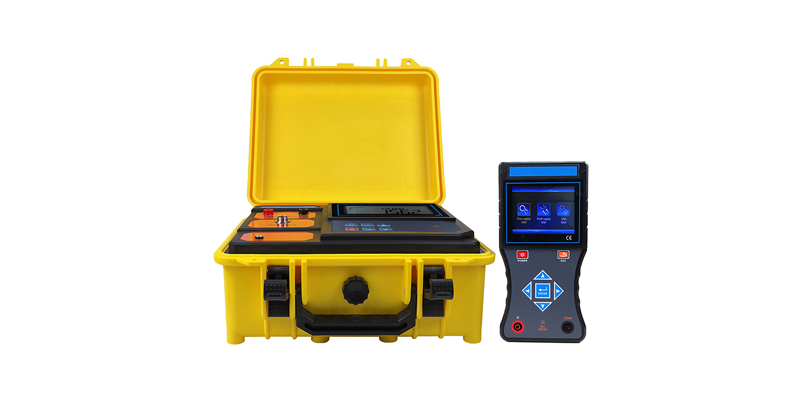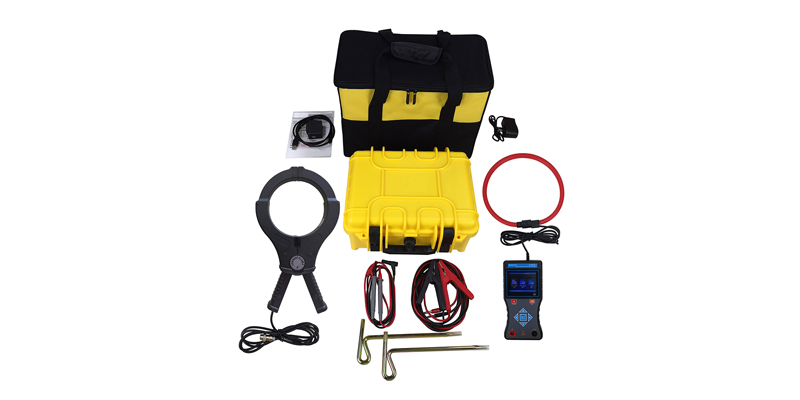


Cable Identifier ( for energized and de-energized cables)
General Information:
Live cable identifier, also known as cable identifier,multi-function cable identifier, and intelligent cable identifier, is designedfor power cable engineers and cable technicians to solve the technical problemsof cable identification. The user can accurately identify one of the targetcables from the multiple cables through the instrument to avoid serious accidents caused by accidentally sawing the live cable. The cable identification starts from the operation of the two ends of the cable. It must be ensured that the double numbering at both ends of the cable is accurate. Itconsists of a receiver and a receiving flexible current clamp. When a livecable is identified, 10 cables can be pre-calibrated at the transmitting endand then received at the remote end, which greatly saves the operation time of engineering personnel and improves work efficiency.
Transmitter: Recognize live cable,transmit signal to target cable during power cable identification, built-inhigh-function rechargeable lithium battery, automatic impedance matching, fully automatic protection. The transmitter adopts an integrated special toolbox design, using polypropylene plastic as a raw material, and adding a new type of composite filler for one-time injection molding, which has low density, strength, rigidity, hardness, wear resistance, heat resistance, and insulation performance. The cabinet can withstand a pressure of about 200kg. The large LCD of the host displays the remaining battery power in real time, with white backlight and dynamic indication of the transmitted signal.
Transmitting clamp: When the live cable is identified, the transmitting clamp couples the signal sent by the transmitter to the target cable, the clamp size is Φ125mm, the transmitting clamp has directionality, and the transmitting signal flows from the arrow icon on the transmitting clamp.
Energized identification: use caliper coupling to output pulse current, transmit four frequencies: 625Hz,1562Hz, 2500Hz, 10kHz, couple to the target cable through the launch clamp (thetarget cable is a three-core armored cable), inject composite pulses into the cable core Current signal. This pulse current generates an electromagnetic field around the target cablefor detection and identification by the receiver and the flexible currentclamp. Because the pulse current has directionality, the detection also has directionality.
De-energized identification: Directly output pulse current is used to inject a pulse-coded current signal into thecable core. This current generates an electromagnetic field around the target cable for the receiver, flexible current clamp to detect, decode, and identify, Because the current hasdirectivity , the detection also has directivity
Receiver: Handheld device, 3.5-inchcolor LCD screen, built-in high-speed microprocessor, combined with precisealgorithm, to identify and decode the pulse-coded current signal of thetransmitter The cable shows the signal strength and the detection result, whichis exquisite and intuitive; the color scale bar is dynamically displayed, at aglance, the cable identification is successfully marked √,and the non-target cable is marked with x, which can quickly and automatically identify the target cable. At the same time, the test voltage range is AC 0.00V
Flexible current clamp: Rockwell coil, with excellent transient tracking ability, can quickly identify the pulse code current generated by the transmitter, suitable for thick cablesor irregular shaped conductors. The inner diameter of the clamps is about 200mm,which can clamp cables under Φ200mm, without disconnecting the measured line,non-contact measurement, safe and fast.
Technical Specifications:
1. Baseline conditions and working conditions
| Influence | Baseline conditions | Working conditions | Remark |
| Environmental Temperature | 23℃±1℃ | -10℃~40℃ | / |
| Environmental Humidity | 40%~60% | | / |
| Measured voltage and current frequency | 50Hz±1Hz | 45Hz~70Hz | When testing voltage and current |
| Receiver operating voltage | 7.4V±0.5V | 7.4V±1V | / |
| Transmitter working voltage | 11.1V±0.5V | 11.1V±1.5V | / |
| External electric field, magnetic field | Should be avoided | ||
| Tested cable location | The cable under test is at the approximate geometric center of the flexible current clamp | ||
2. Transmitter specifications
| Function | Transmits a composite pulse frequency current signal, displays the remaining battery voltage, and dynamically indicates the launch status |
| Power | 11.1V large-capacity rechargeable lithium battery, continuous working for about 8 hours when fully charged |
| Output | Caliper coupling during live identification. Direct output during power outage identification |
| Transmit frequency | 625Hz, 1562Hz, 2500Hz, 10KHz (when charged identification), press the up and down arrow keys to adjust the transmission frequency |
| Pulse voltage | 500V (de-energized) |
| Pulse current | Maximum 5A (depending on the size of the loop resistance) |
| Pulse frequency | 1 time / second |
| Pulse width | 2ms |
| Test lead length | 3 meters, with crocodile clamps, 1 red and black |
| Transmitter clamp size | LWH 320mm×180mm×35mm |
| Transmitter clamp inner diameter | φ125mm |
| Transmitter clamp lead length | 4m |
| Ground pin size | LWH 225mm×100mm×10mm |
| Transmitter size | 320mm×275mm×145mm |
| Display mode | Large LCD displays real-time remaining battery voltage, with backlight |
| LCD size | Length width 128mm × 75mm, display area 124mm × 67mm |
| Package size | LWH 400mm×245mm×335mm |
| Working temperature | -10℃~40℃ |
| Storage conditions | -20℃~50℃,≤95%RH, No condensation |
| Backlight control | Yes, white backlight |
|
|

